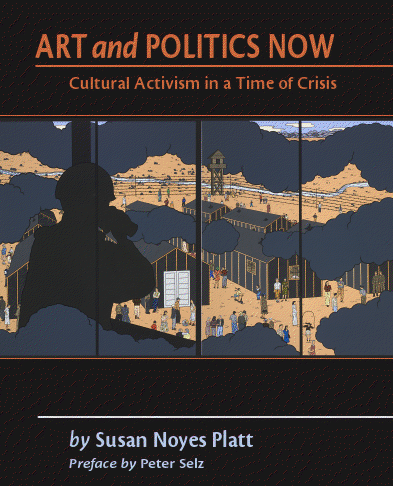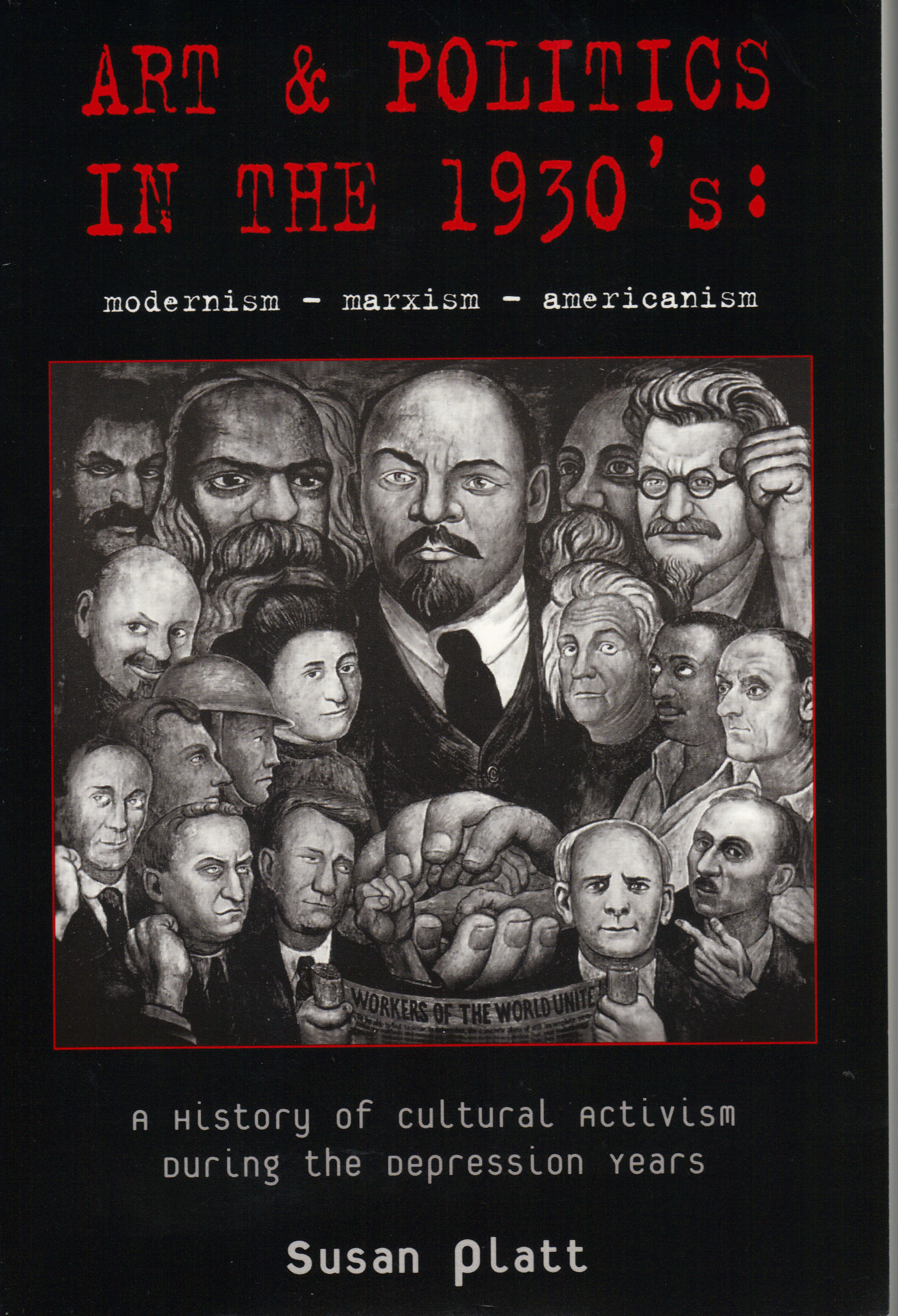

During the 1930s, artists and critics were activists. In the United States, they aggressively intervened in both the art world and the “real” world in order to put art in touch with society, to interpret and to celebrate an art that protested injustice, and to encourage participation in political activity. This book excavates that activism even as it charts it’s complexity.
Rather than simply narrating what people did as activists, this book analyzes the theoretical foundations of 1930s activism, based in three concepts, Americanism, Modernism, and Marxism. Throughout the book, though, I demonstrate the ways in which these ideas were constantly changing and the ways in which they intersected, often within the same person. I create unpredictable pairings, such as Alfred Stiegliitz’s connection to leftist labor activists and the role of abstract artists on the left. The New Deal as a site of the cross currents of all of these ideas is laid out by tracing the amazing work of Holger Cahill and other New Deal administrators, particularly Audrey McMahon. At the center of the book are the shifting positions of the far Left between 1930 and 1939, from Proletarianism to the Popular Front and finally the preemption left rhetoric by Clement Greenberg’s rhetoric.
“Erotic Mythmaking and Depression Politics: Alfred Stieglitz and Dorothy Norman”
On May 1, 1934, Alfred Stieglitz (1864 – 1946) guru of one wing of the American Modernist avant-garde stood in the front row of a huge crowd in New York City to lobby Mayor Fiorello La Guardia for a municipal art gallery. That same day he spoke to a mass meeting of over one thousand people at the New School for Social Research. He later called it one of the “Red Letter Days” of his life. (image)
Dorothy Norman(1905-1997) was instrumental in constructing a new Stieglitz mythology that would fit the 1930s. Norman first appeared at the Stieglitz gallery in the late 1920s as the pregnant young wife of a millionaire. She had worked with the American Civil Liberties Union and on Margaret Sanger’s campaign for birth control. Her youth, beauty, and naivete about art as well as her ardent responses engaged Stieglitz immediately, and she, in turn, was captivated by the experience of Stieglitz and his gallery.
The Norman/Stieglitz collaboration was highly charged erotically. … The most significant “offspring” of their relationship, though were the “stories” that Norman published about Stieglitz.. . . While collectively the Stieglitz stories in Twice a Year were intended to be anti-Fascist, when looked at individually, thematically and as fictions, they construct the Stieglitz identity . . . as a fighter against the evils of society . . .
Katherine S. Drier’s “Confliction Passions Modernism and German Nationalism” Among the many alliances of art, activism, and politics during the Depression, none is more enigmatic than that of Katherine S. Dreier ( 1877 – 1952). Dreier was a pioneer abstract painter who was also committed to collecting and explaining modern art. She promoted her belief in Modernism tirelessly in lectures and publications, based on insights gained from her own work as an abstract painter and her study of theosophy.
Yet in complete contradiction to her fervent campaign for Modernism and her feminism, Dreier was also an ardent German nationalist. She had an almost unshakable admiration for Hitler, a man whose values were the antithesis of those she held most sacred – individuality, creativity, and humanity.
The Search for a Usable Past
From Van Wyks Brooks, Thorstein Veblen and John Dewey to Lewis Mumford, Constance Rourke, Alain Locke, and Suzanne La Follette
The ‘usable past’ developed against the background of the escalating immigration of Jews and other ethnic groups from Europe as well as African Americans from the South during the first two decades of the twentieth century. Given these vast numbers of new arrivals in urban America, intellectuals tried to differentiate a “real” America. This America was often based on the pre-Civil war era. . . As it elevated early American, Anglo-Saxon culture, this “usable past” could be clearly racist. But that was not always true – it also became one model for African Americans in particular in reevaluating their culture and their identity.”
Alain Locke ( 1886 – 1954) leading articulator of the philosophy of the new Negro during the Harlem Renaissnace, was also a major participant in Americanist discourse in the twenties and thirties. . . . While W.E.B. Du Bois confronted racism in all its manifestations, Alain Locke focused practically exclusively on culture as a means to liberation.
“Stump Politics, Street Fights and Mass Media: Thomas Craven, Thomas Hart Benton, and Stuart Davis”
Craven stripped Americanism to a balder, more nationalistic statement that fueled racism. Craven was unusual as an art journalist, successfully pairing populism with art history, playing on sex and innuendo, much in the manner of a contemporary talk-show host.
Benton’s America Today(1930) is a tribute to industrial progress; it celebrates the energy of American factory workers, the energy of the frontier and western honky-tonk life. The Arts of Life in America includes a few large scale figures that become romantic caricatures, similar to those of movies and cartoons . . . Stuart Davis accused Benton of racism.
“Critic with a Conscience: Elizabeth McCausland at the Springfield Republican”
The passionate writing of Elizabeth McCausland ( 1899 – 1965) broke through the conventions of both traditional journalism and art criticism in the 1930s to become a powerful voice for freedom of expression and the political involvement of artists. For McCausland as for many artists of the thirties, the concept of freedom did not imply freedom to abandon all responsibility, but rather freedom to demonstrate, to be political, to resist totalitarian domination. It meant that artists should be free to address the serious political and economic issues of the world. McCausland forcefully articulated the profound convictions, fears and joys of newly socially engaged art world.” (see Elizabeth McCausland’s article “Art, Politics and Sexuality”)
“Deep on the Left: Artists, Writers, and the Proletariat”
In Proletarianism, judgment of the efficacy of art depended on the politics of the artist and the success of the art in rousing people to action for social change. That commitment to effect change was balanced by a desire to create sophisticated art, not simply propaganda.
In Man at the Crossroads Diego Rivera placed the worker in the central position in society, with his hand on the source of energy. He is poised between the decadent and brutal world of Capitalism and the energized, cooperative world of Communism. . . The mural proved too inflammatory and Rivera was ordered to stop work.
In a fascinating intersection of radical ideology and bourgeois capital, it was at the New Workers School, with Rockefeller money, that Rivera painted his mural cycle Portrait of America, the history of class struggle in America. In the series of more than twenty panels Rivera presented the dark side of American history, ranging from the brutalities of colonization to the demagogic leaders of the thirties.
After working with Rivera at Rockefeller Center and at the New Workers School, Ben Shahn actually completed his first mural in Jersey Homesteads( now Roosevelt) New Jersey community center with funding from the New Deal Resettlement Administration.
“From Stalinism to Abstract Art: Charmion von Wiegand”
Charmion von Wiegand (1896 – 1983) charted the rapidly changing ideologies of the Left in the second half of the thirties. She pursued dramatic shifts in theory and practice that provide a case study of the pressures on participants in the Communist discourse. Daughter of an eminent Hearst journalist, she began the decade as an enthusiastic advocate for Soviet-style Communism, next supported German Expressionism, turned to Marxist cultural theory, particularly the ideas of the German art historian Max Raphael, then became an abstract painter under the sway of Mondrian, and finally converted to Buddhism.
“The Mexico/New York Axis: Anita Brenner”
Anita Brenner (1905 – 1974) represents one example of anti-Stalinism. Her writings in the mid thirties have an affinity with many of Trotsky’s ideas. She even facilitated his final exile in Mexico with Diego Rivera and Frida Kahlo. In the 1930s she was a respected political and cultural commentator. In fact, Brenner’s ideas were formed as an art critic working in the heat of the Mexican mural renaissance of the early 1920s. She was an ardent promoter of Mexican art and an expert on the political events in Mexico.
“Diverse Advocates for A Popular Front”
Art Front prominent from 1934 to 1937 is one example of the complicated negotiations during the Popular Front era between the agenda of the Left and traditional artists for whom individuality and aestheticism were sacrosanct.
“The Power of Populism at the Federal Art Project” Far from a unified hegemonic intervention, the New Deal administrators were constantly scrambling and improvising just to function from day to day. Despite these complications of power, the art programs did succeed in producing what New Deal ideologues referred to as “cultural democracy.”
In Harlem, government sponsorship built on an ongoing commitment to community art instruction and community pride. Although the main funds came as part of a package of federal spending following the Harlem riots of 1935, the support for an art center was in response to community demands and interests, not an artificial intervention. Well-established leaders of the Harlem Renaissance like the sculptor Augusta Savage and the painter Aaron Douglas were highly qualified candidates for federal aid.
Augusta Savage actually reached her artistic peak as a result of government patronage in the thirties. She received a prominent commission for the New York World’s Fair in 1939. Cast in plaster and painted to resemble basalt, Lift Every Voice and Sing was based on the poem by the Harlem Renaissance poet, James Weldon Johnson that became the Negro national anthem.
“Critical Intervention for the Preservation of Modernism: Alfred H. Barr Jr, and the Museum of Modern Art”
In February 1936, while Leftist activism reached its zenith of power at the American Artists Congress and the New Deal was at its height, Alfred H. Barr, JR. ( 1902 – 1981), the still youthful director of the Museum of Modern Art, went on the offensive for his own cause, the survival of Modernism.”
“From Hatred to Hegemony: Activists for Abstraction in the Late Thirties”
Modernism, now with abstraction as its defining feature was taken up by artists and critics who held a wide spectrum of political and social positions.
At the infamous Degenerate Art Exhibition held in Munich in 1937 in juxtapostion with the much larger Great German Art Exhibition, the Nazis used derogatory slogans to inflame viewers against works by 112 well known modern artists.
Celebrity Bauhaus professors, in flight from Hitler, like Moholy-Nagy and Joseph Albers, brought with them a deeply thought-out argument on the significance of abstract art and formalism.
“Modernism and Marxism Clement Greenberg and the Partisan Review”
Clement Greenberg must be seen against the background of the inquisitions of the House UnAmerican Activities Committee (HUAC).
In the March of 1939 Hitler took over Czechoslovakia in violation of the Munich pact of the previous fall, and went on to form an alliance with Stalin in August, 1939, shortly before the declaration of war against Germany by England and France. The motivating force of the Popular Front had been a united front in opposition to Fascism. The alliance of Hitler and Stalin shattered that possibility.
In the midst of all of these political traumas and realignments in 1939, Clement Greenberg was drafting his famous essay, “Avant-Garde and Kitsch.”
It is my hope that critics and artists can return to the vital role they played in the thirties. We cannot allow public discourse on art to remain by default, dominated by the conservative agenda of repression. The future of society as a whole is once again on the line.
© Susan Platt